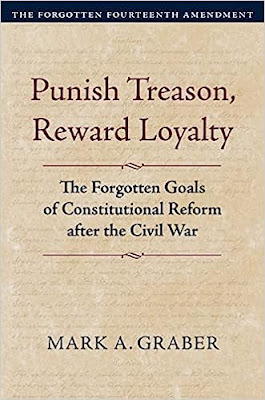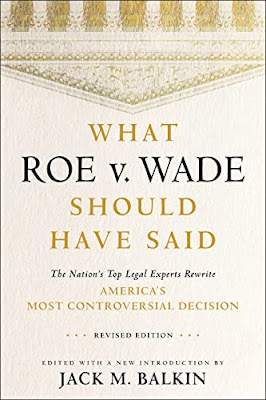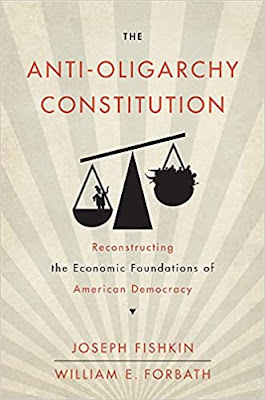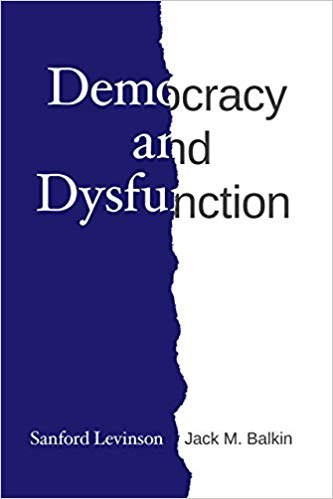Balkinization
an unanticipated consequence of
Jack M. Balkin
Balkinization Symposiums: A Continuing List
E-mail:
Jack Balkin:
jackbalkin at yahoo.com
Bruce Ackerman
bruce.ackerman at yale.edu
Ian Ayres
ian.ayres at yale.edu
Corey Brettschneider
corey_brettschneider at brown.edu
Mary Dudziak
mary.l.dudziak at emory.edu
Joey Fishkin
joey.fishkin at gmail.com
Heather Gerken heather.gerken at yale.edu
Abbe Gluck abbe.gluck at yale.edu
Mark Graber
mgraber at law.umaryland.edu
Stephen Griffin
sgriffin at tulane.edu
Jonathan Hafetz
jonathan.hafetz at shu.edu
Jeremy Kessler
jkessler at law.columbia.edu
Andrew Koppelman
akoppelman at law.northwestern.edu
Marty Lederman
msl46 at law.georgetown.edu
Sanford Levinson
slevinson at law.utexas.edu
David Luban
david.luban at gmail.com
Gerard Magliocca
gmaglioc at iupui.edu
Jason Mazzone
mazzonej at illinois.edu
Linda McClain
lmcclain at bu.edu
John Mikhail
mikhail at law.georgetown.edu
Frank Pasquale
pasquale.frank at gmail.com
Nate Persily
npersily at gmail.com
Michael Stokes Paulsen
michaelstokespaulsen at gmail.com
Deborah Pearlstein
dpearlst at yu.edu
Rick Pildes
rick.pildes at nyu.edu
David Pozen
dpozen at law.columbia.edu
Richard Primus
raprimus at umich.edu
K. Sabeel Rahmansabeel.rahman at brooklaw.edu
Alice Ristroph
alice.ristroph at shu.edu
Neil Siegel
siegel at law.duke.edu
David Super
david.super at law.georgetown.edu
Brian Tamanaha
btamanaha at wulaw.wustl.edu
Nelson Tebbe
nelson.tebbe at brooklaw.edu
Mark Tushnet
mtushnet at law.harvard.edu
Adam Winkler
winkler at ucla.edu
Compendium of posts on Hobby Lobby and related cases
The Anti-Torture Memos: Balkinization Posts on Torture, Interrogation, Detention, War Powers, and OLC
The Anti-Torture Memos (arranged by topic)
Recent Posts
Valuing Privacy Harms while Structuring Data Governance
Just A Few Blogs
ACS Blog
Alas, a Blog
Althouse
Arts and Letters Daily
Atrios (Eschaton)
Bill of Health
Buzzflash.com
Buzz Machine
Cato at Liberty
Juan Cole (Informed Comment)
Concurring Opinions
The Constitution in 2020
Corrente
Crooked Timber
Daily Howler
Daily Kos
Dana Boyd
Brad DeLong
Digby (Hullabaloo)
Discriminations
Daniel Drezner
Kevin Drum (Mother Jones)
Electrolite
En Banc
Eunomia (Daniel Larison)
Fafblog
Michael Froomkin (Discourse.net)
GovLab (Beth Noveck)
Rick Hasen (Election Law)
History News Network
How Appealing
Ignatz (Sam Heldman)
The Importance of (Ernie Miller)
Infolaw
Instapundit
International Economic Law and Policy Blog
IntLawGrrls
Jacob Levy
Jesus' General
Jurisdynamics
The Kitchen Cabinet
Mark Kleiman
Law Blog Central
Larry Lessig
Lawyers, Guns and Money
Liberal Oasis
Brian Leiter's Law School Reports
The Leiter Reports
Marginal Revolution
Megan McArdle
Memeorandum
Metafilter
Mirror of Justice
The New Republic
Newseum
No More Mister Nice Blog
Brendan Nyhan
Opinio Juris
Orcinus
The Originalism Blog
Pandagon
Passport (Foreign Policy)
Overcoming Bias
Political Animal (Washington Monthly)
Political Theory Daily Review
Political Wire (Taegan Goddard)
The Poor Man
Virginia Postrel
Prawfsblawg
Public Reason
Jonathan Rauch
Raw Story
Redstate
ReligiousLeftLaw.com
Reporters Committee For Freedom of the Press
Reproductive Rights Blog
Rothman's Roadmap to the Right of Publicity
SCOTUS Blog
Seeing the Forest
Clay Shirky
The Shifted Librarian
The Situationist
Larry Solum (Legal Theory)
Andrew Sullivan
Talking Points Memo
Talk Left
Tapped
Tbogg
TechPresident
The Paper Chase (Jurist)
Tom Paine
Tom Tomorrow (This Modern World)
Eve Tushnet
Uggabugga
University of Chicago Law School Faculty Blog
Unqualified Offerings
The Volokh Conspiracy
War and Piece (Laura Rozen)
Wampum
Oliver Willis
Wonkette
Written Description
Matthew Yglesias
Yin
Your Choice of Feeds
1. XML
powered by
2. Atom Feed
3. RSS 2.0
Valuing Privacy Harms while Structuring Data Governance
Guest Blogger
For the Balkinization Symposium on Ignacio Cofone, The Privacy Fallacy: Harm and Power in the Information Economy Cambridge University Press (2023). Frank Pasquale Ignacio Cofone’s The
Privacy Fallacy is an important contribution to a rapidly growing
literature on data protection. He critiques over-reliance on contract law in
the governance of data, and the need for tort principles to compensate for (and
deter) privacy harms. He articulates a complex theory of privacy liability that
is capacious enough to address a wide range of harms arising out of data
breaches, misuses of sensitive information, and other wrongs. This post is
largely an appreciation of the book, with a few closing thoughts on two areas
of future work it invites: better valuation of privacy harms, and more robust
structures of data governance. Cofone
sets the stage by arguing that a core legal rationale for the obligations and
opportunities embedded in digital data transactions today is a lie. As he
observes: Privacy consent is
an illusion. Consent-based privacy protections allow corporations to do as they
please with people’s data as long as they’re able to extract superficial
agreement. We routinely experience this (lack of) protection when we mechanically
click “I agree” to websites’ and apps’ terms of service. Individual consent
provisions fail to address the harms produced by aggregated, inferred, and relational
data. They ignore information asymmetry, lack of choices, and unequal bargaining
(66). Far too many contracts “unshackle[]
informational exploitation” rather than offering robust protections. Aware of this,
many voices in privacy law have tried to improve consent—for example, by making
it more informed. Cofone calls these “traditionalist solutions,” and many do
seem obsolete. The overwhelming weight of dark
patterns and manipulation
online, as well as the many offline pressures contributing to social
acceleration, make it exceptionally difficult for any consumer to sagely
weigh the costs and benefits of granting data to one entity and denying it to
another. As Cofone argues, “information overload prevents us from realizing how
much risk our information involves.” This is a
critically important set of observations, because it helps turn upside down the
longstanding effort by to trivialize privacy injuries as speculative. Both in
damages determinations and in standing doctrine, US courts are all too willing to
deny or marginalize a claim based on a data breach or invasion of privacy
because of the plaintiff’s inability to demonstrate the concrete and particular
harm arising out of a particular offense. But that very same rationale--the
great difficulty of predicting when and where data will be used against someone--also
undermines the legitimacy of any contract premised on a data subject’s rational
projection of the costs and benefits of the transaction. While many
scholars have exposed the hollow normative core of privacy policies, Cofone marshals
arguments here with expertise and force. He also offers a quite conditional
endorsement of reformist measures, judging that “moving privacy consent from an
opt-out to an opt-in model, establishing contract law mechanisms, and
reinforcing privacy notices….work as palliative solutions that are helpful only
as long as they don’t distract from meaningful ones.” So what are these
meaningful forms of regulation? Cofone gives an overview of at least three.
First, there should be prohibitions of “high-risk data practices, likely to be
against collective best interests” (104). Presumably such high-risk practices
would include several of the specific misuses of data Cofone profiles in the
book, which give a “human face” to what is an often-abstract enterprise. Cofone
also proposes that the “noncompliant corporation faces a fine (public
enforcement), monetary damages (private right of action), or both” (105). The
“both” option would be a useful upgrade to, for example, federal U.S. health
privacy law enforcement, where at present the Health Insurance Portability and
Accountability Act (HIPAA) only permits fines. Second, Cofone
counsels for more use of standards in privacy regulation, instead of rigid
rules. Facing a fast-moving market for data, regulators need the broad
authority inherent in authorities like “data minimization” standards, which “corporations
to consider alternatives and adopt the one that requires the least data to
achieve the desired outcome” (106). “Privacy by design” is another such
standard, focused on the planning of product and service offerings. Though firms will complain about standards’
indeterminacy, it is blackletter U.S. administrative law that agencies have
some degree of discretion in choosing between rulemaking and adjudication to
enforce a statute, absent some direct legislative mandate for one or the other
approach. Moreover, as Cofone notes, repeated application will “flesh out” a
standard. Third, Cofone examines
one particular overarching standard—that of a fiduciary—as a way of
re-orienting data processors toward recognizing the best interests of those
whose data they collect. There has been
fierce debate over the information fiduciary standard (as first developed by Jack
Balkin) since Lina Khan and David Pozen published their “A
Skeptical View of Information Fiduciaries” in 2019. Cofone acknowledges the
value of the fiduciary approach, as well as the validity of some issues the
critics raise. In Chapters 6 and 7 of the book he proposes alternative forms of
liability for many troubling data practices, based on an analysis of a wide
range of potential harms caused by negligent or reckless collection, analysis,
and use of data. Cofone’s list of objective
data harms is worth quoting in full: Data harms include
reputational harm (for example, when employers find inaccurate information
about a job candidate), financial harm (such as identity theft), physical harm
(like doxing, where the disclosure of personal information often leads to
bodily harm), discrimination (for example, when a member of a nonvisible minority
is outed), and harms to democracy (such as when someone’s tricked into voting for
a candidate they wouldn’t have voted for otherwise). Cofone argues that all these harms
involve actual adverse consequences to data subjects. (Some are also known as
“consequential harms” in U.S. caselaw.) Rife with comparative insights, The
Privacy Fallacy also demonstrates that they constitute “material harms”
pursuant to the GDPR. Cofone creatively analogizes such harms to battery, and
argues that, just as psychological harms arising out of a battery can be
compensated, so too should psychological or subjective harms (arising out of
the material and objective harms of data practices) be compensable. (This is a
nice adjunct to arguments for greater recognition of subjective distress in
Citron & Solove’s classic “Privacy
Harms” article.) However, his survey of U.S., Canadian, and European
rulings in the area shows that there are numerous hurdles to assuring
compensation for the full range of privacy harms, as well as some important
opportunities. For
Cofone, there are numerous routes for assuring better remedies for privacy
harms. On his account, “Liability can be brought through three legal pathways.
First, when a data practice breaches a privacy or data protection statute (for
example, breaching someone’s right to know). Second, through a violation of
data security law (for example, failing to notify [data subjects about] a data
breach [affecting them]). Third, through privacy torts in common law
jurisdictions or the law of obligations in civil law jurisdictions (for
example, intrusion upon seclusion)” (139).
He notes that while, on paper, the GDPR gives far greater scope for
private rights of action than the U.S., most privacy enforcement in Europe is
still public. To
broaden the scope for privacy protection, Cofone proposes a private right of
action [PRA] in privacy laws, broader and more forceful than extant
PRAs in U.S. federal and state
statutes, and those in the GDPR. A key reform appears to be legislation that guarantees
that “the right to sue doesn’t hinge on material, consequential harm” (143). He
also wants to ensure that the right to sue survives exculpatory clauses sure to
be included in online terms of service. Cofone points to hopeful signs in
Commonwealth countries’ privacy jurisprudence that expand privacy rights to
address modern threats and respect modern mores. He also tours the varied successes and
failures of efforts to expand privacy liability beyond tangible, consequential
harm, to include immaterial harm. For Cofone, “courts can and should focus on
privacy harm, rather than consequential harms, produced by data practices that
breach statutory rules or privacy policies – that is, taking the opposite
direction of the US Supreme Court in the TransUnion case.” The remainder
of the chapter examines whether liability’s basis should be negligence or
no-fault, and the procedural dimensions of the expanded privacy liability
Cofone proposes. Valuation and Governance in a
Dual Remedial Regime The
Privacy Fallacy offers an ambitious vision for better vindicating privacy
rights. It also suggests an expansive research agenda for future work. Two
questions particularly intrigue me going forward. First, what methods of
valuation might best ensure just remedies for wronged data subjects? Second,
how should courts and regulators coordinate in order to rationally divide the
labor of privacy protection? We might
explore each of these through the lens of a concrete example explored by Cofone
throughout the book: the dating app Grindr’s sale of “its users’ personal
information to third parties, which included sexual orientation and HIV status.” As
for the first question, Cofone mentions that Grindr faced a “historic fine”
imposed by the Norwegian DPA for its misdeeds: €9,600,000, or ten percent of
its global revenue in 2020 (according to the DPA’s website). Cofone recommends
dual remedial regimes, where victims of illegal data practices can sue in
courts, while regulators pursue parallel administrative proceedings. One issue
that arises out of this dual regime is how to coordinate damages, and their respective
purposes. I am not certain as to whether DPAs keep the fines they collect, or
seek to compensate victims with them, or some combination of those goals. I
assume that, by proposing a dual remedial regime, Cofone would prefer for the
DPAs to keep the fines (to better fund future investigations), at least up to a
point, while encouraging courts to find proper levels of compensation—but more
clarity on this point would be welcome. At
the judicial level, proper levels of compensation are a fascinating topic.
Cofone cites an article
by Jojo Y.C. Mo with extensive discussion of remedies, and I hope the field
follows both Mo’s and Cofone’s lead in exploring the proper level of punishment
and compensation due. After another HIV-related privacy breach, Aetna (a US
insurer) settled
a case involving the illegal revelation of about 12,000 persons’ status for $17
million—roughly $1,400 per person had it been distributed equally. This
figure is the same order of magnitude as the £3500 and £5000 privacy damages
awards in Britain mentioned in Mo’s article.
The £3500 case
involved a famous model, who was photographed leaving a drug rehabilitation
clinic, and who recovered damages for misuse of private information. The small
award does not seem like adequate recompense for the anguish the model
suffered. Nor does it seem likely to deter major media firms from engaging in
similarly invasive conduct in the future. But Britain is a loser-pays legal
system, and presumably the model incurred high attorneys fees to press her
case. I hope to see
future work exploring the bases of privacy harm valuations. Perhaps they
reflect the theories of probabilistic harm explored by Cofone. The Aetna breach
occurred because “the fact that [affected data subjects] had been taking HIV
drugs was revealed through the clear window of the envelope” sent to them,
which contained a letter regarding a prior Aetna privacy violation. The
settlement established a two-tier remedy framework, according to reporting
on the case: As part of the
payout, the law firms are setting aside at least $12 million for payments of at
least $500 to the estimated 11,875 people who may have received a letter
exposing that information. . . . A fund will be set up for those who
experienced additional financial or emotional distress. Individuals will be
able to claim up to $20,000. The rest of the money will go toward legal fees
and costs. On one level, this seems like a
sensible outcome. Some claimants may not have had any impact from the careless
printing of the HIV-related information on the envelope window. The $500 award
to them simply serves to deter misconduct, rather than to recompense harm.
However, on the opposite end of the scale, the $20,000 figure seems inadequate
to truly recompense plausible “worst case scenarios,” given the potential for
stigma documented in the complaint. For example, it is
possible that one in a thousand persons had truly catastrophic results from the
breach—say, being disowned, ostracized, shunned, or fired once the information
spread. The distress and economic damage arising out of those catastrophic
cases might be valued at $1 million or more. It is relatively easy to imagine
tragic sequelae of a privacy violation—and the unimaginative can find
instruction in the facts of Doe
v. Medlantic. But this raises other difficult questions. For example, when should
class action settlements be shared equally by members of the class, and when
should those who are particularly harmed receive more? Perhaps the latter lost
their right to make their own individual case when they failed to opt out. But
fuller consideration of these issues would enrich future discussions of the
privacy class actions which Cofone endorses. A second question
that arose for me after reading The Privacy Fallacy was the proper
coordination of non-monetary, judicial remedies with regulators’ demands. It
seems that plaintiffs who demand equitable remedies are in a sense acting as
private attorneys general (in U.S. parlance). To offer a concrete example: PRAs
in California filed pursuant to the California Consumer Privacy Act (CCPA) may
give rise to equitable remedies that duplicate, exceed, or fall short of
relevant regulatory requirements crafted by the California Privacy Protection Agency
(CPPA). It would seem advisable for courts to at least consult these regulatory
requirements. And when courts prescribe equitable remedies whose demands exceed
what regulators presently demand, that should be an opportunity for the CPPA to
re-examine whether its own regulations are too lax. It is to Cofone’s
great credit that The Privacy Fallacy raises such intriguing questions.
The book clearly advances our understanding of the difficult challenges ahead
in balancing the rights of businesses and consumers, as well as the
responsibilities of supranational, national, and subnational regulators. I look
forward to Cofone’s further work in the area, as his remarkably cosmopolitan
perspective and passion for social justice greatly enriches contemporary
privacy law discourse.
Posted
9:30 AM
by Guest Blogger [link]
Books by Balkinization Bloggers

Linda C. McClain and Aziza Ahmed, The Routledge Companion to Gender and COVID-19 (Routledge, 2024)

David Pozen, The Constitution of the War on Drugs (Oxford University Press, 2024)

Jack M. Balkin, Memory and Authority: The Uses of History in Constitutional Interpretation (Yale University Press, 2024)

Mark A. Graber, Punish Treason, Reward Loyalty: The Forgotten Goals of Constitutional Reform after the Civil War (University of Kansas Press, 2023)

Jack M. Balkin, What Roe v. Wade Should Have Said: The Nation's Top Legal Experts Rewrite America's Most Controversial Decision - Revised Edition (NYU Press, 2023)

Andrew Koppelman, Burning Down the House: How Libertarian Philosophy Was Corrupted by Delusion and Greed (St. Martin’s Press, 2022)

Gerard N. Magliocca, Washington's Heir: The Life of Justice Bushrod Washington (Oxford University Press, 2022)

Joseph Fishkin and William E. Forbath, The Anti-Oligarchy Constitution: Reconstructing the Economic Foundations of American Democracy (Harvard University Press, 2022)

Mark Tushnet and Bojan Bugaric, Power to the People: Constitutionalism in the Age of Populism (Oxford University Press 2021).

Mark Philip Bradley and Mary L. Dudziak, eds., Making the Forever War: Marilyn B. Young on the Culture and Politics of American Militarism Culture and Politics in the Cold War and Beyond (University of Massachusetts Press, 2021).

Jack M. Balkin, What Obergefell v. Hodges Should Have Said: The Nation's Top Legal Experts Rewrite America's Same-Sex Marriage Decision (Yale University Press, 2020)

Frank Pasquale, New Laws of Robotics: Defending Human Expertise in the Age of AI (Belknap Press, 2020)

Jack M. Balkin, The Cycles of Constitutional Time (Oxford University Press, 2020)

Mark Tushnet, Taking Back the Constitution: Activist Judges and the Next Age of American Law (Yale University Press 2020).

Andrew Koppelman, Gay Rights vs. Religious Liberty?: The Unnecessary Conflict (Oxford University Press, 2020)

Ezekiel J Emanuel and Abbe R. Gluck, The Trillion Dollar Revolution: How the Affordable Care Act Transformed Politics, Law, and Health Care in America (PublicAffairs, 2020)

Linda C. McClain, Who's the Bigot?: Learning from Conflicts over Marriage and Civil Rights Law (Oxford University Press, 2020)

Sanford Levinson and Jack M. Balkin, Democracy and Dysfunction (University of Chicago Press, 2019)

Sanford Levinson, Written in Stone: Public Monuments in Changing Societies (Duke University Press 2018)

Mark A. Graber, Sanford Levinson, and Mark Tushnet, eds., Constitutional Democracy in Crisis? (Oxford University Press 2018)

Gerard Magliocca, The Heart of the Constitution: How the Bill of Rights became the Bill of Rights (Oxford University Press, 2018)

Cynthia Levinson and Sanford Levinson, Fault Lines in the Constitution: The Framers, Their Fights, and the Flaws that Affect Us Today (Peachtree Publishers, 2017)

Brian Z. Tamanaha, A Realistic Theory of Law (Cambridge University Press 2017)

Sanford Levinson, Nullification and Secession in Modern Constitutional Thought (University Press of Kansas 2016)

Sanford Levinson, An Argument Open to All: Reading The Federalist in the 21st Century (Yale University Press 2015)

Stephen M. Griffin, Broken Trust: Dysfunctional Government and Constitutional Reform (University Press of Kansas, 2015)

Frank Pasquale, The Black Box Society: The Secret Algorithms That Control Money and Information (Harvard University Press, 2015)

Bruce Ackerman, We the People, Volume 3: The Civil Rights Revolution (Harvard University Press, 2014)
Balkinization Symposium on We the People, Volume 3: The Civil Rights Revolution

Joseph Fishkin, Bottlenecks: A New Theory of Equal Opportunity (Oxford University Press, 2014)

Mark A. Graber, A New Introduction to American Constitutionalism (Oxford University Press, 2013)

John Mikhail, Elements of Moral Cognition: Rawls' Linguistic Analogy and the Cognitive Science of Moral and Legal Judgment (Cambridge University Press, 2013)

Gerard N. Magliocca, American Founding Son: John Bingham and the Invention of the Fourteenth Amendment (New York University Press, 2013)

Stephen M. Griffin, Long Wars and the Constitution (Harvard University Press, 2013)

Andrew Koppelman, The Tough Luck Constitution and the Assault on Health Care Reform (Oxford University Press, 2013)

James E. Fleming and Linda C. McClain, Ordered Liberty: Rights, Responsibilities, and Virtues (Harvard University Press, 2013)
Balkinization Symposium on Ordered Liberty: Rights, Responsibilities, and Virtues

Andrew Koppelman, Defending American Religious Neutrality (Harvard University Press, 2013)

Brian Z. Tamanaha, Failing Law Schools (University of Chicago Press, 2012)

Sanford Levinson, Framed: America's 51 Constitutions and the Crisis of Governance (Oxford University Press, 2012)

Linda C. McClain and Joanna L. Grossman, Gender Equality: Dimensions of Women's Equal Citizenship (Cambridge University Press, 2012)

Mary Dudziak, War Time: An Idea, Its History, Its Consequences (Oxford University Press, 2012)

Jack M. Balkin, Living Originalism (Harvard University Press, 2011)

Jason Mazzone, Copyfraud and Other Abuses of Intellectual Property Law (Stanford University Press, 2011)

Richard W. Garnett and Andrew Koppelman, First Amendment Stories, (Foundation Press 2011)

Jack M. Balkin, Constitutional Redemption: Political Faith in an Unjust World (Harvard University Press, 2011)

Gerard Magliocca, The Tragedy of William Jennings Bryan: Constitutional Law and the Politics of Backlash (Yale University Press, 2011)

Bernard Harcourt, The Illusion of Free Markets: Punishment and the Myth of Natural Order (Harvard University Press, 2010)

Bruce Ackerman, The Decline and Fall of the American Republic (Harvard University Press, 2010)
Balkinization Symposium on The Decline and Fall of the American Republic

Ian Ayres. Carrots and Sticks: Unlock the Power of Incentives to Get Things Done (Bantam Books, 2010)

Mark Tushnet, Why the Constitution Matters (Yale University Press 2010)
Ian Ayres and Barry Nalebuff: Lifecycle Investing: A New, Safe, and Audacious Way to Improve the Performance of Your Retirement Portfolio (Basic Books, 2010)
.jpg)
Jack M. Balkin, The Laws of Change: I Ching and the Philosophy of Life (2d Edition, Sybil Creek Press 2009)

Brian Z. Tamanaha, Beyond the Formalist-Realist Divide: The Role of Politics in Judging (Princeton University Press 2009)

Andrew Koppelman and Tobias Barrington Wolff, A Right to Discriminate?: How the Case of Boy Scouts of America v. James Dale Warped the Law of Free Association (Yale University Press 2009)

Jack M. Balkin and Reva B. Siegel, The Constitution in 2020 (Oxford University Press 2009)
Heather K. Gerken, The Democracy Index: Why Our Election System Is Failing and How to Fix It (Princeton University Press 2009)

Mary Dudziak, Exporting American Dreams: Thurgood Marshall's African Journey (Oxford University Press 2008)

David Luban, Legal Ethics and Human Dignity (Cambridge Univ. Press 2007)

Ian Ayres, Super Crunchers: Why Thinking-By-Numbers is the New Way to be Smart (Bantam 2007)

Jack M. Balkin, James Grimmelmann, Eddan Katz, Nimrod Kozlovski, Shlomit Wagman and Tal Zarsky, eds., Cybercrime: Digital Cops in a Networked Environment (N.Y.U. Press 2007)

Jack M. Balkin and Beth Simone Noveck, The State of Play: Law, Games, and Virtual Worlds (N.Y.U. Press 2006)

Andrew Koppelman, Same Sex, Different States: When Same-Sex Marriages Cross State Lines (Yale University Press 2006)
Brian Tamanaha, Law as a Means to an End (Cambridge University Press 2006)
Sanford Levinson, Our Undemocratic Constitution (Oxford University Press 2006)
Mark Graber, Dred Scott and the Problem of Constitutional Evil (Cambridge University Press 2006)
Jack M. Balkin, ed., What Roe v. Wade Should Have Said (N.Y.U. Press 2005)
Sanford Levinson, ed., Torture: A Collection (Oxford University Press 2004)
Balkin.com homepage
Bibliography
Conlaw.net
Cultural Software
Writings
Opeds
The Information Society Project
BrownvBoard.com
Useful Links
Syllabi and Exams